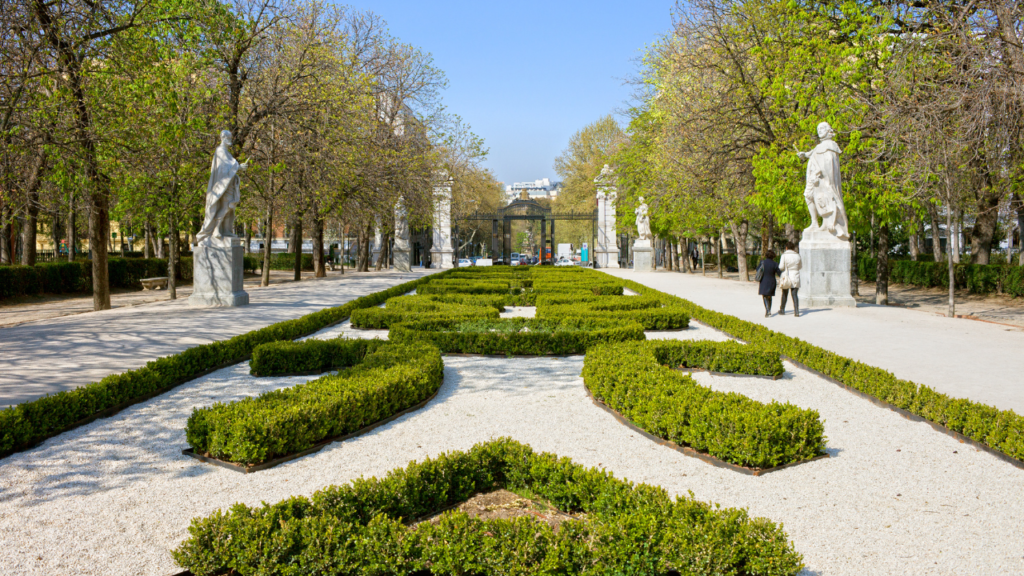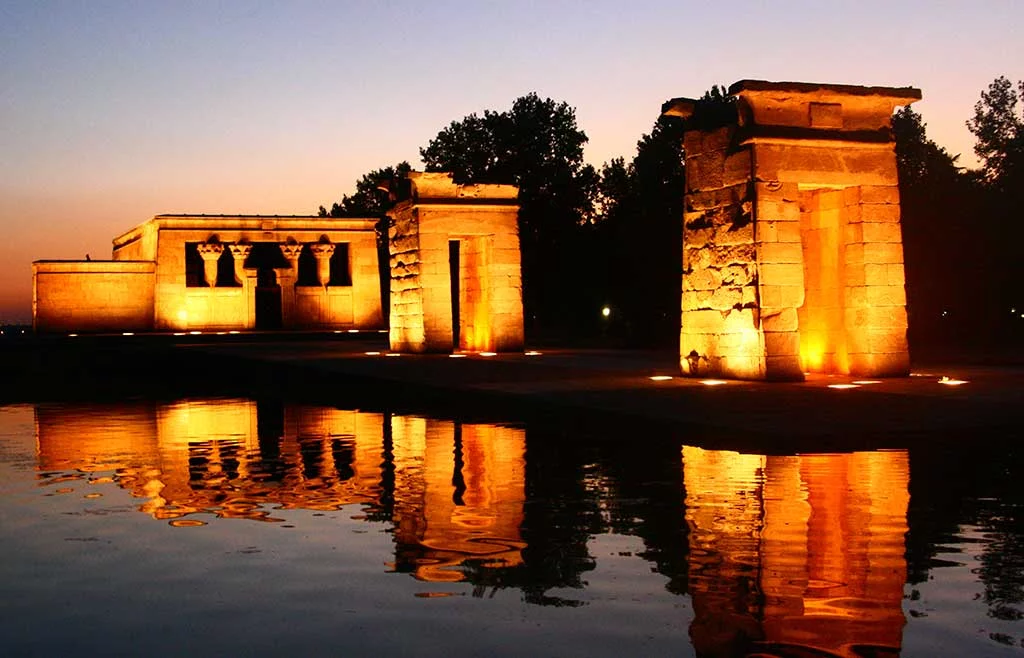10 Must-Sees in Madrid in Springtime
Hello, travelers and adventure lovers! Here in Trip Tours Madrid, your favorite free tours agency in the capital, we are ready to guide you through the must-see places to visit in Madrid this spring. Madrid gets beautiful in spring, and we’re here to make sure you don’t miss the best of the best. Get ready for a mix of culture, history, art and, of course, fun!
Springtime in Madrid is waiting for you
Madrid in spring is a spectacle of flowers, full terraces and a sun that invites you to get lost in its streets full of history. But do you know which are the 10 must-haves of this month? Read on!
1. El Retiro: Urban Oasis
Nothing says “spring in Madrid” like a stroll through El Retiro Park. Amid palatial buildings, ponds, and street artists, this park is the perfect place to enjoy a picnic under the blooming almond trees. Between palaces, ponds, and street performers, the park offers the perfect setting to enjoy a day outdoors. Be sure to visit the Crystal Palace and immerse yourself in one of the temporary contemporary art exhibitions organized there.
El Retiro Park is not only a place for recreation and beauty, but also a space filled with history and curiosities. One of the most fascinating is the existence of an underground bunker built during the Spanish Civil War. This shelter, located beneath the Cuesta de Moyano, was designed to protect citizens from bombings and is one of many constructed in Madrid during the conflict.
In addition to the bunker, the park houses the Great Pond, where you can rent a boat and enjoy a peaceful ride on the water, surrounded by an impressive view of the Monument to Alfonso XII. Another point of interest is the Fountain of the Fallen Angel, one of the few public sculptures in the world dedicated to the figure of Lucifer, and curiously located at 666 meters above sea level, a detail that attracts both history buffs and lovers of the mysterious.
These features make El Retiro not just a place to relax and enjoy nature, but also a space where history and culture meet, offering visitors a unique and enriching experience in the heart of Madrid.

2. El Rastro: Flea Market with History
Sundays in Madrid have a name: El Rastro. Let yourself be carried away by its streets and discover from antiques to the latest vintage fashion.
The Rastro de Madrid is more than just a simple flea market; it is a true cultural icon with a rich history that dates back to the mid-17th century. Originally, this place was an informal market set up by workers from the nearby slaughterhouse, who sold used clothes and objects they collected from the trash, giving rise to the name “rastro,” which refers to the traces of blood dragged through the streets.
Over time, El Rastro evolved into the vibrant open-air market it is today, stretching through the streets of the Lavapiés neighborhood and attracting both locals and tourists. It is famous for its diversity of products, where one can find everything from antiques, furniture, books, vintage clothing, and art, to second-hand items and local crafts. Additionally, it is a key spot for bargain hunters and collectors of unique objects.
El Rastro is also a social hub, where the hustle and bustle of shopping are accompanied by live music and street performances. The nearby bars and cafes fill with people enjoying tapas and drinks, making Sunday at El Rastro a culturally immersive experience. This market is not only a place for shopping but also for experiencing the vibrant social and cultural life of Madrid.
3. Royal Palace: Time Travel
Be impressed by the magnificence of the Royal Palace. We recommend the guided tour to learn all its secrets and anecdotes.
The Royal Palace of Madrid is not only the official residence of the King of Spain for state ceremonies; it is also the largest royal palace in Western Europe in terms of area. Built on the ruins of the old Alcázar, which was destroyed by fire in 1734, the Royal Palace as we know it today was designed by the architect Filippo Juvarra and his disciple Juan Bautista Sachetti, marking a reference point in Spanish Baroque architecture.
One of the most impressive features of the palace is the Royal Pharmacy, which preserves a remarkable collection of porcelain jars, ingredients for medicines, and ancient recipes, reflecting the importance of health at the Spanish court. Additionally, the Palace houses the only Porcelain Room in all of Europe, completely clad in this material, which is a testament to the luxury and opulence of the Spanish monarchy.
Within its walls, the Royal Palace also holds the Palatine Stradivarius, an invaluable collection of instruments created by the famous luthier Antonio Stradivari. These instruments, which include violins, violas, and cellos, are considered among the most precious in the world and are occasionally used in special concerts.
Each room of the Palace tells a story, from the majestic State Halls to the Throne Room, where one can admire impressive frescoes by Tiepolo and delicate stucco work. The guided tour of the Royal Palace is not just a lesson in history and art, but an opportunity to better understand the life and politics of the Spanish monarchy over the centuries.

4. Temple of Debod: Magical Sunsets
One of the best places to watch the sunset in Madrid is, without a doubt, the Temple of Debod. This ancient Egyptian temple, a gift from Egypt to Spain, offers one of the most romantic views of the city.
One of the best places to watch the sunset in Madrid is undoubtedly the Temple of Debod. This ancient Egyptian temple, a gift from Egypt to Spain, offers one of the most romantic views of the city.
The Temple of Debod is one of the most exotic and surprising jewels of Madrid. This ancient Egyptian temple, dating back to the 2nd century BC, was given to Spain by Egypt in 1968 as a thank you for Spanish help in saving the Nubian temples, particularly during the campaign to save Abu Simbel during the construction of the Aswan Dam.
One of the most fascinating features of the Temple of Debod is that it is one of the few examples of ancient Egyptian architecture that can be seen outside of Egypt, and it is the only one of its kind in Spain. The temple was originally dedicated to the god Amun of Debod and later to Isis, and it offers a unique insight into the religious beliefs and life in ancient Egypt.
The temple’s location in the West Park, near the center of Madrid and on an elevated promontory, makes it an ideal place to watch the sunset. The reflections of the temple on the nearby pond and the evening light create a magical and almost surreal atmosphere, making it one of the best spots in the city to enjoy panoramic sunset views. Additionally, the park surrounding the Temple of Debod is adorned with pathways, fountains, and rest areas that allow visitors to enjoy a moment of peace and tranquility amidst the bustling life of the capital.

5. Gran Vía: Heart of Madrid
You can’t say you’ve been to Madrid without strolling down Gran Vía. From classic cinemas to the most modern shops, this street is the vibrant soul of Madrid.
Gran Vía is more than just a street; it is a vital artery that reflects the vibrant spirit of Madrid and its evolution throughout the 20th century. Inaugurated in 1910, this iconic avenue was designed as part of an ambitious modernization plan to connect the northwest of the city to the center. Over the years, Gran Vía has become the stage for numerous historical, cultural, and social events, reflecting the contemporary history of Spain.
Known as the “Madrid Broadway,” Gran Vía is famous for its numerous theaters offering a wide range of performances, from large-scale musicals to dramas and comedies, attracting both national and international talents. The Lope de Vega Theater and the Rialto Theater are two of the most prominent, known for hosting some of Spain’s most important productions.
6. San Miguel Market: A Feast for the Senses
For foodies, the Mercado de San Miguel is a must-visit stop. Tapas, wines, and delights of all kinds await you at this historic iron market.
Located near the Plaza Mayor in Madrid, the Mercado de San Miguel is more than just a market; it is a true gastronomic temple that encapsulates the essence of Spanish cuisine. This historic iron market, opened in 1916, has been meticulously restored to become one of the city’s main culinary centers. Here, visitors can sample everything from traditional tapas and select wines to gourmet products and innovative dishes offered by the various stalls.
What makes the Mercado de San Miguel special is its vibrant and cosmopolitan atmosphere, where both locals and tourists gather to enjoy the culinary experience. Each stall in the market offers a different specialty, from fresh seafood and Iberian ham to artisan cheeses and fine pastries. This market is not just a place to eat; it is also a space to socialize and enjoy the culture of tapas, so ingrained in Spanish life.
7. Barrio de las Letras: Literary Walk
The Barrio de las Letras, also known as the writers’ quarter, is one of the most charming districts in Madrid. This neighborhood was home to some of Spain’s greatest writers during the Golden Age, such as Cervantes, Quevedo, and Lope de Vega, whose works still resonate in world literature. Walking through its cobblestone streets is like strolling through a poem, with literary quotes engraved on the ground that invite reflection on the cultural legacy of the neighborhood.
In addition to its rich literary history, the Barrio de las Letras is a vibrant place full of life, with numerous bars, cafés, restaurants, and small art and antique shops. It is the perfect place to experience the bohemian life of Madrid, with a cultural offering that includes everything from small art galleries to independent theaters.
Walk the same streets once trod by Cervantes, Quevedo and Lope de Vega. This neighborhood breathes art and history in every corner.

8. Prado Museum: A Journey through Art
The Prado Museum is a must-see for art lovers.
for art lovers. From Velázquez to Goya, prepare to be amazed by some of the most important works in history.
The Prado Museum is not just one of the most important art museums in the world; it is a chair in the history of European art. Founded in 1819, this museum houses an unparalleled collection of more than 8,000 works of art, with a particular focus on Spanish masters such as Velázquez, Goya, and El Greco, although it also stands out for its collections of Italian and Flemish masterpieces.
A visit to the Prado Museum offers a deep immersion into the works that have defined the Western artistic landscape, featuring not only paintings but also sculptures, drawings, and other artworks. The rooms dedicated to Velázquez and the majestic “Las Meninas,” or the “Black Room” that houses Goya’s black paintings, are just some of the highlights that no art lover should miss.

9. Chueca: Neighborhood of Diversity
Chueca is synonymous with diversity, nightlife, and the best alternative shopping. Don’t miss its bars and the opportunity to experience the most authentic Madrid.
Chueca is synonymous with diversity and modernity in the heart of Madrid. This neighborhood is known for its active LGBTQ+ community, being the center of nightlife and alternative culture in the city. With a vibrant mix of trendy bars, nightclubs, designer stores, and cafes, Chueca invites everyone to enjoy its welcoming and inclusive atmosphere.
During the day, Chueca is a hub of activity with fashionable stores and boutique markets offering everything from vintage clothing to modern art. At night, the neighborhood transforms, offering one of the best nightlife scenes in Madrid, with a wide range of entertainment from quiet bars to vibrant nightclubs where music and dancing continue until dawn.
10. Madrid Río: Nature in the City
To finish, a walk along Madrid Río will let you enjoy nature without leaving the city. Perfect for a relaxed day with the family.
At Trip Tours Madrid, we are ready to make your visit to Madrid an unforgettable experience. Whether you prefer a guided tour through the city’s most iconic corners or a personalized adventure, we are here for you!
Madrid Río is a splendid example of urban regeneration and sustainability that transforms the city’s relationship with its river, the Manzanares. This linear park, stretching over 7 kilometers on both sides of the river, offers a green oasis amidst the urban hustle and is a perfect destination for families, athletes, and anyone looking for a break from city life.
Opened in 2011, Madrid Río has been meticulously designed to provide leisure and recreation spaces for all audiences. Among its many attractions, it features thematic children’s play areas, outdoor sports facilities, rest areas, and an urban beach, ideal for the warmer months. Additionally, the park boasts walking and cycling paths, allowing visitors to enjoy a natural environment without having to leave the city.
The design of Madrid Río is also highlighted by its bridges and pedestrian walkways, including the futuristic Arganzuela Bridge, whose metal structure is illuminated at night creating an impressive visual spectacle. This bridge is not only functional but has become a symbol of modernization and infrastructure improvement in the capital.
Don’t forget to visit our Upcoming Events page to join our next adventures exploring the sites to visit in Madrid this spring.
Explore with us!
Don’t forget that you also have the opportunity to immerse yourself in our cultural experiences through our free tours available here.
Other Free Tours!
 CONTACT
CONTACT


